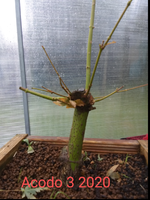When does a leaf produce the whole energy it consumed for growing? I know it depends on many factors, however what I am trying to understand is: does a growing little tiny green sprout of leaf start photosynthesis as it gets the green color or does it wait until hardening?
The photocenters that power photosynthesis have to be built in the emerging leaf, in presence of light. The green coloration gets darker as more photocenters are created and the net rate of photosynthesis must correspondingly ramp up, but I cannot say exactly when a leaf crosses the line to being a net energy producer. I'm just sure that it is in this state (of being a net energy producer) when the leaf is flat or 'hardened'.
The red color of red leafed varieties comes from anthocyanins that are in a layer of leaf tissue above the photocenters. Their function is to shade the photocenters from sunlight. If you have the leaves emerge in shade, say, the photosynthetic apparatus will be 'shade adapted'. If you then move the tree into full sun, the leaves will get a darker muddy red coloration because anthocyanins are produced to keep the intense sunlight damage. Many red leafed varieties have a similar dark red coloration normally, but it tends to fade if the leaf is shaded - the anthocyanins get removed to uncover the underlying chlorophyll green. My point is only that seeing a dark green leaf color generally works, but color alone isn't a reliable criterion. The concept is basically correct, but it is the presentation of flat, mature leaf is more reliable criterion.
Another question, in terms of light pruning, what would be the exact timing to prune a branch considering it produced as much as it consumed? I am trying to figure out 'wasted energy is regained' situation.
Trees are made of the same stuff that produces and uses as 'energy' - elementary sugars. In scientific studies, the dry weight of trees is used as the energy metric. This kind of measurement is literally a dead end. In bonsai practice, though, we are wanting stem thickening when we fret about 'energy', I think. Maximal energy utilization, in this sense, occurs if one simply lets it grow'. Specifically, letting a branch run all season will thicken the branch most rapidly. It is simply a matter of maximal leaf area and auxin production, as well as exposure to sunlight (energy input).
You could do a bit of scientific study yourself by choosing to lop off all of a season's growth, measuring the dry weight of what you lop off and also measuring the thickness change of the base branch. I think you will find that letting the branch grow all season produces the most dry weight in what is pruned off (versus say the total dry weight of multiple prunings during the season) as well as the most gain in the caliper of the base branch.
Thickening is driven by the flow of carbohydrate and auxin down the stem. When the new growth is extending, auxin is being consumed locally to affect elongation of the new cells. As the branch gets longer, a progressively lower fraction of the auxin is consumed locally and so more goes down the stem stimulating cambium cell division and consumption of sugars supplied via the phloem = making the stem thicken. Every time you prune, you reset this process and so, 'waste energy'.
An extreme version is pinching or removing the tip when it is soft. This removes the dominant auxin producer. Hence growth tends to just stop until a remnant bud at the base of a leaf is released (which can be as long as a sizable fraction of the growing season). People use this as a maintenance technique because they don't want their maple canopy to get larger and they don't want their branches to thicken. Energy isn't being wasted, per se, because little is being produced. However the vitality of a tree kept in this state can decline markedly over the span of a few seasons (there is not quite enough auxin to affect root growth which, in turn, means lower levels of cytokinins are produced to release buds, etc.).
yadda yadda yadda









